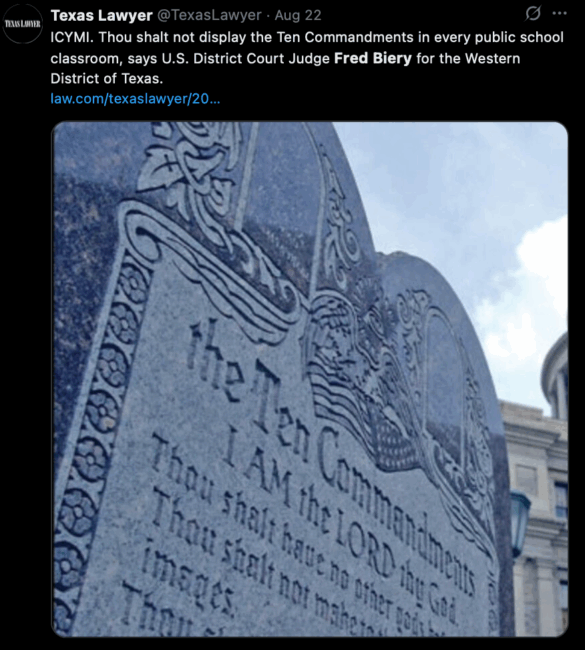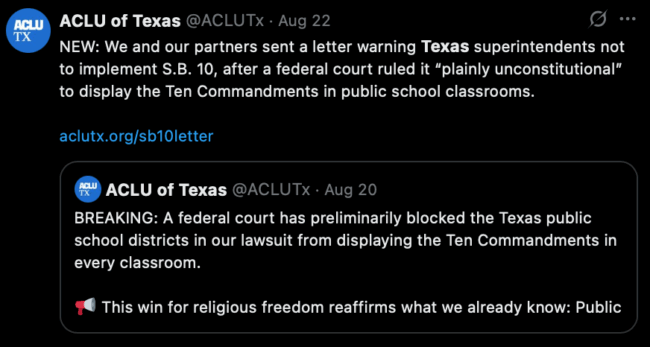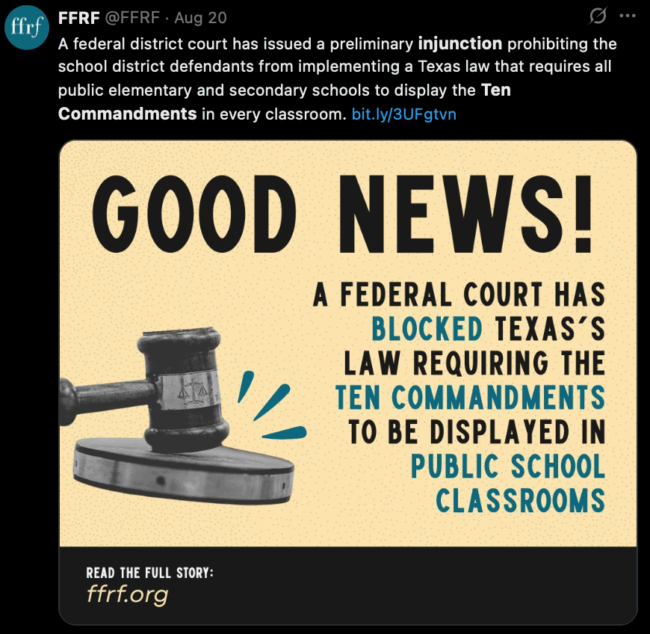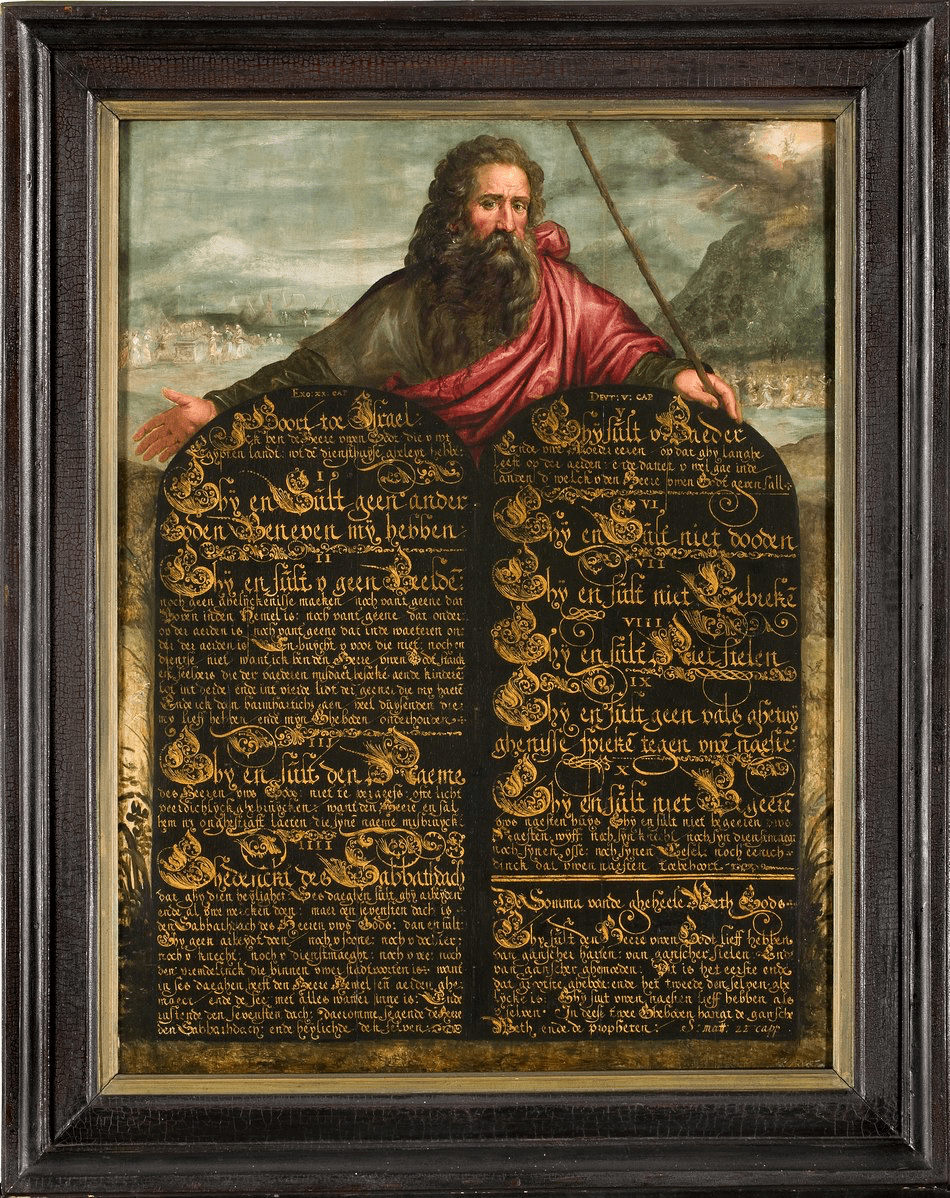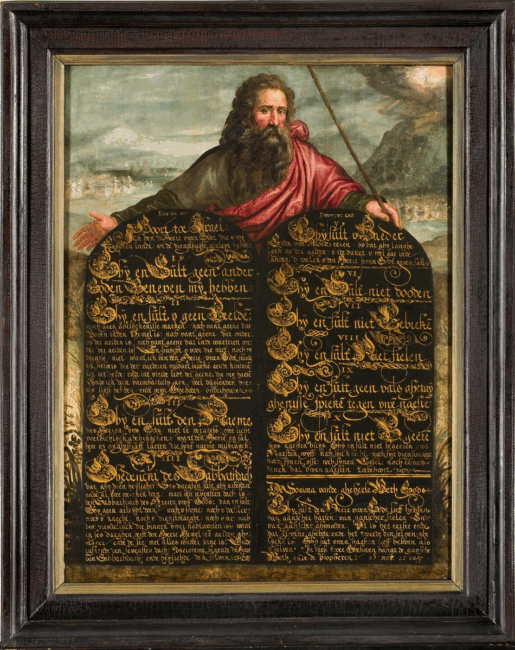
Like a few other states, Texas enacted a bill that mandated that every school within every district must put up a poster within every single classroom displaying the Ten Commandments.
The bill was titled SB 10 – and yes, they were indeed making sure the bill had a 10. Officially the bill is supposed to take effect on September 1. When drafting they had also learned a few lessons that others had discovered the hard way. The bill is very specific about the size of the poster, and it also stipulates the precise text in english.
What has previously happened in previous attempts was malicious compliance. Proposals to get around such regulations by displaying a postage stamp sized poster, and others had proposed having it in either Klingon or Arabic, so Texas was careful with the wording and managed to duck all that.
Actually, despite trying to be really careful they still managed to screw it up. The legislation does not include any enforcement mechanism or penalties—no fines, sanctions, or disciplinary measures are outlined for non-compliance. A state House committee analysis explicitly noted that the bill did not create a criminal offense. In other words, for the schools that simply ignore it nothing will happen, because nothing legally can happen.
However, something truly wild has indeed just happened – a federal judge has just blocked it.
We are building up to a truly wild and distinctly unique legal ruling by a judge, so stick with me here, because even those involved did not see it coming like this.
The Build up and background to the Ruling
Once HB10 had been enacted and signed, 16 families pushed back and sued their school districts … not the state … but their school districts.
- You can find the 65 page filing for that lawsuit here – dated July 2, 2025
Briefly … it points out that there exists a vast diversity of different faiths and no faiths mandated to attend school. They are now being mandated to have a Protestant version of the 10 commandments inflicted upon them. This is not constitutional, and SCOTUS has already established that doing this breaches the First Amendment. It also goes on to point out that the goal of SB10 is to specifically impose religious belief on Kids, and quotes various legislators confirmed this, hence they seek a ruling that S.B.10 is unconstitutional.
Judgement
On August 20, 2025 they get exactly what they asked for (via the Freedom from Religion Press release) …
In a victory for religious freedom and church-state separation, a federal district court has issued a preliminary injunction prohibiting the school district defendants from implementing a Texas law that requires all public elementary and secondary schools to display the Ten Commandments in every classroom.
In his decision in Rabbi Nathan v. Alamo Heights Independent School District today, U.S. District Court Judge Fred Biery held that Texas Senate Bill 10, which is due to take effect on Sept. 1, likely violates both the Establishment and Free Exercise Clauses of the First Amendment.
Ruling that the law would likely lead to unconstitutional religious coercion of the child plaintiffs and interfere with their parents’ rights to direct their children’s religious education, Judge Biery explained:
“The displays are likely to pressure the child-plaintiffs into religious observance, meditation on, veneration, and adoption of the state’s favored religious scripture, and into suppressing expression of their own religious or nonreligious background and beliefs while at school.”
A preliminary injunction, a clear and concise victory … end of story … right?
Well … not quite.
What the above “We won, we got an injunction” press release skates over is just how wild the issued preliminary injunction actually is.
Hint: It runs to 55 pages and is far more than the usual one page single paragraph “IT IS THEREFORE ORDERED that … yada yada” you might normally expect. That bit is there, it is on page 55. What leads up to it is why I’m writing about this.
What is in the injunction?
It might actually be quicker to cover what is not in the injunction. Clearly Judge Fred Biery decided “F**k it, I’m going gloves off on this one“
Side note: It’s a preliminary injunction and it only applies to the school districts named in the lawsuit. We still await his decision to see if it will actually apply state wide.
So what exactly is in this injunction.
It has a biblical themed opening …
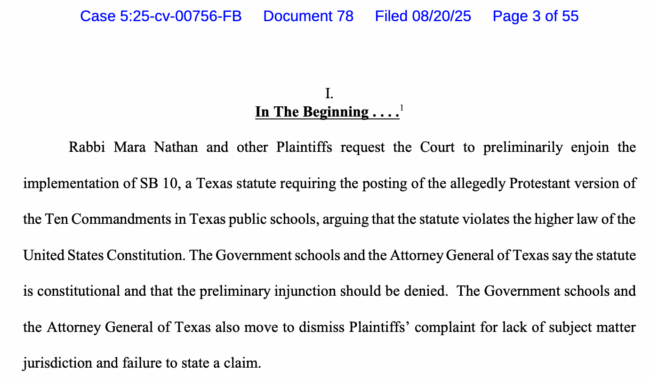
That is page 3. At this point the next 20 pages … yes really 20 pages … covers in great detail a rather accurate and quite concise history of religious conflict … like this …
While “We the people” rule by a majority, the Bill of Rights protects the minority Christians in Hamtramck and those 33 percent of Texans who do not adhere to any of the Christian denominations.
It can be argued that the genesis of this controversy was about 4,000 years ago when Abraham “separated” from the “government” of his family history and traditions of many gods to proclaim the monotheistic belief in “the one true God.” Abraham begat his descendants Moses, Jesus of Nazareth and Muhammad, who form the triad of the “desert religions” and the “peoples of the Book”: Torah, Christian Bible and the Quran. On other parts of the Earth, different groups of humans developed their own spiritual, philosophical and religious belief systems, many of which have come to exist in the American experience and experiment of democracy and self-government.
Actually, he also takes us a lot further back …
Eternity is a Long Time
Diversity of Homo Sapiens Religious and Life After Death BeliefsThough most of the eight billion Homo sapiens have no knowledge they are traveling 66,000 miles per hour around the sun, they have evolved over several million years to be the only species which knows it will die.
Not wanting their existence to end, Homo sapiens developed a multitude of theories and hopes, encompassed in thousands of religions, of how they can avoid returning to the Earth from whence they and other species came. Or, as the country western song says: “Everybody wanna go to heaven, but nobody wanna go now.” In the past 10,000 years of human societal development, those belief systems have included the multiple gods of the ancient Romans, Greeks and Egyptians, the monotheism of the Abrahamic religions of Judaism, Christianity and Islam, the reincarnation beliefs of Buddhism, and the various religious beliefs and practices of the Shintoists, Hindus, Mayans, Aztecs and Incas, to name but a few.
Reminder: This is a formal legal injunction issued by a court.
For all he states, he also has footnotes and references.
He lays out the rather dire and bloody history of religious conflict …
While religious institutions bestow many blessings and try to alleviate suffering, those acts of Grace are neutralized by religious Homo sapiens who exhibit an historical and continuing pernicious and pervasive tendency to kill other humans and confiscate the property of those, sometimes even within the same religion, who do not believe as they do. Christians slaughtered other Christians. In Europe, the blood of Irish Protestants and Catholics flowed freely. Similar conflict between Protestants and Catholics existed in the United States as well. In colonial Salem, Massachusetts, Christians savagely punished women accused of being witches. Other Christians rejected the Church of Jesus Christ of Latter-Day Saints as cultists, using brute force against them. Radical Islamic Sunni and Shiites create chaos within their culture. Christians attempted to exterminate Jews. Some Muslims view non-Muslims as infidels. Christians crusaded against Muslims. Conflict between Orthodox Jews and secular Jews in Israel begets harsh and uncivil acts.
This gets up to page 8 … we still have a long way to go yet.
Yes, it is a legal injunction, but it is also worth a read.
Oh and he also has pictures that illustrate religion and government joining hands …
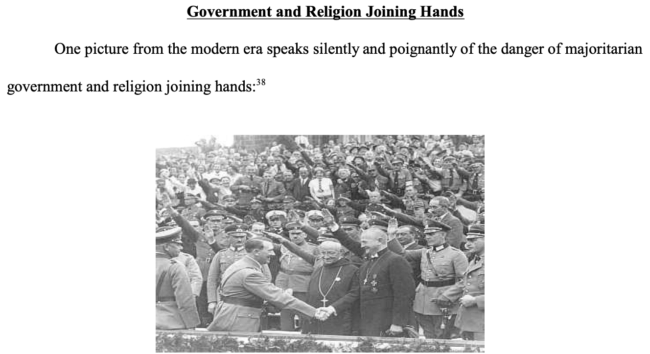
He knows his ruling will greatly piss off Republicans, and I guess he decided to call a spade a spade and is calling them out (implicitly) as fascists (which to be frank is now a factual observation).
Where he next goes is to sp[ell out his legal obligations …
The United States Has No King: The People Are Sovereign
The Constitution invokes, and is based upon, the people as having ultimate sovereignty and power over the three branches of government through the electoral and amendment processes vested in them. That power, for example, has been exercised to allow women to vote, to prohibit, and then allow, liquor and to limit the President of the United States to two terms.
The people could exercise that same power to amend the Constitution to favor a particular religion, to turn the United States into a religious theocracy such as Israel or Iran or to suppress religion as in the Soviet Union, China or Cambodia under the Khmer Rouge.
Thus far, that power has not been exercised in such a manner, and this Court’s obligation is to follow the Constitution as written, as intended by the Framers and as interpreted by the Supreme Court of the United States.
He then proceeds to go into what the constitution says and what the intent of it all was. All is familiar stuff such as quotes from James Madison and Jefferson’s 1802 “Wall of separation” letter to the Danbury Baptist’s, then on to quotes from Benjamin Franklin and Thomas Paine.
From there he proceeds to lay out a lot of detail regarding US Legal History on all of this, and then begins to drill down into previous decision regarding Ten Commandments displays.
Plaintiffs
He makes the point that this is not belief vs non-belief …
Plaintiffs subscribe to a wide range of religious and non-religious views including Unitarian Universalism, Judaism, Reform Judaism, Presbyterian Christianity, atheism, non-religiousness and agnostic atheism. They allege that the version of the Ten Commandments set out in Texas’ Ten Commandments law differs from the version observed by some Protestant faiths, and most adherents of the Catholic and Jewish faiths. Plaintiffs further assert that many other religions do not regard the Ten Commandments as part of their belief systems at all.
… and that this is clearly one variation of belief attempting to suppress others …
Plaintiffs assert the displays will: (1) forcibly subject the minor-child Plaintiffs to religious doctrine and beliefs in a manner that conflicts with their families’ religious and non-religious beliefs and practices; (2) send a marginalizing message to the minor-child Plaintiffs and their families that they do not belong in their own school community because they do not subscribe to the state’s preferred religious text; (3) religiously coerce the minor-child Plaintiffs by pressuring them to observe, meditate on, venerate, and follow the state’s favored religious text, and by pressuring them to suppress expression of their own religious or nonreligious beliefs and backgrounds at school; and (4) substantially interfere with the religious development of the minor-child Plaintiffs and threaten to undermine the beliefs, practices, and values regarding matters of faith the parents wish to instill in their children, thereby usurping the parents’ authority to direct their children’s religious education and religious or nonreligious upbringing.
He proceeds to dig into precise details for each of the Plaintiffs, for example the Jewish family, or the Christian Family with a different tradition.
Page 46 – The Preliminary Injunction – Arguments for and against
Finally we get to the actual preliminary injunction itself.
There were various “experts”. One is called out (politely) …
The Court heard from and is very appreciative of the testimony of Dr. Steven Green and Dr. Mark Hall, which was an extensive augmentation of the Court’s 20 years of Methodist Sunday School and theology, political philosophy and constitutional history courses at Texas Lutheran University. The Court finds Dr. Green’s opinions concerning the intent of the Founders regarding the First Amendment to be more persuasive than Dr. Hall’s testimony.
Side Note: Hall is a Christian Nationalist – Here for example is a book review that slices and dices his bogus arguments.
To be a tad more specific, the judge was faced with this from Dr Green…
Plaintiffs presented the expert testimony of Dr. Steven Green, a religious and constitutional legal historian. Dr. Green testified that the public school system did not exist at the founding; rather, public education originated sometime around the late 1820s. Dr. Green also found no evidence that the Ten Commandments were permanently displayed in early American public schools. He testified that no state enacted a law allowing the display of the Ten Commandments in public schools until North Dakota did so in 1927, and that court later stuck down the statute
… and this from Dr Hall …
Dr. Hall testified at the hearing that S.B. 10’s mandate is compatible with the Founding Fathers’ conception of religious liberty. He also testified that “in no way, shape or form, can an original understanding of the First Amendment say that this Amendment was intended to remove religion from the public square.” Here, however, we are talking about public schools, not the public square.
… and so the very obvious rebuttals to that are then articulated …
the district court indirectly addressed Dr. Hall’s conclusions concerning the Founding Fathers’ understanding of the separation of church and state in issuing its preliminary injunction. Id. As the Arkansas court noted, “[t]he Founders were deeply committed to the principle that government must not compel religious observance or endorse religious doctrine, and that commitment is reflected in multiple foundational texts, such as the Declaration of Independence and the Virginia Statute for Religious Freedom, both of which were authored by Thomas Jefferson.” …
… There is also insufficient evidence of a broader tradition of using the Ten Commandments in public education, and there is no tradition of permanently displaying the Ten Commandments in public-school classrooms …
… this Court finds there is is insufficient evidence of a broad tradition in place at the time of the Founding, and within the history of public education, to justify S.B. 10.
There was also a “This has not happened yet, how can there be harm?” – Argument
This is addressed …
As to the second element, a substantial threat of irreparable harm absent the injunction, the Government schools argue that Plaintiffs cannot show any harm because they do not know what the posters will look like and therefore cannot know whether any poster will violate the First Amendment. This argument fails for the same reasons Texas’ ripeness argument fails. S.B. 10’s minimum requirements provide sufficient details about how the Ten Commandments must be displayed. As in Brumley, “Plaintiffs have shown that those displays will cause an irreparable deprivation of their First Amendment rights.
Texas will “suffer[] the irreparable harm of denying the public interest in the enforcement of its laws.”
Again … nope … because …
it does not have a genuine ‘interest in enforcing a regulation that violates federal law
… and also because …
S.B. 10 also impermissibly takes sides on theological questions and officially favors Christian denominations over others. The Supreme Court recently reaffirmed that the Establishment clause requires that the “government maintain ‘neutrality between religion and religion.’” Catholic Charities Bureau, Inc. v. Wisconsin Lab. & Indus. Rev. Comm’n
Conclusions
So are we past all the wild stuff?
Not at all …
Conclusion
Ultimately, in matters of conscience, faith, beliefs and the soul, most people are Garbo-esque. They just want to be left alone, neither proselytized nor ostracized, including what occurs to their children in government run schools.
Even though the Ten Commandments would not be affirmatively taught, the captive audience of students likely would have questions, which teachers would feel compelled to answer. That is what they do. Teenage boys, being the curious hormonally driven creatures they are, might ask: “Mrs. Walker, I know about lying and I love my parents, but how do I do adultery?” Truly an awkward moment for overworked and underpaid educators, who already have to deal with sex education issues
… and so, finally, we get the injunction …
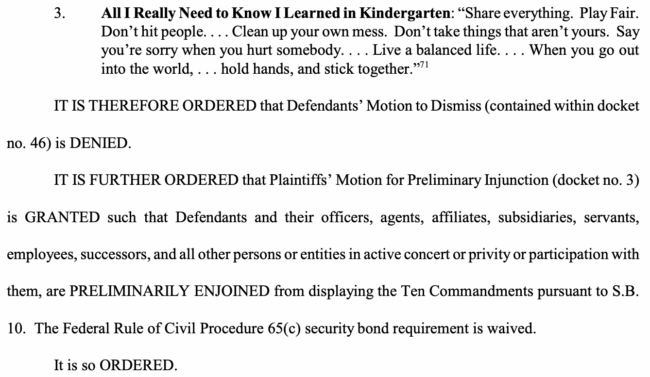
That’s it then… the end of the court filing.
Nope, one one parting shot.
The judge knows how some “Loving Christians” will react to this, so he also added …
For those who disagree with the Court’s decision and who would do so with threats, vulgarities and violence, Grace and Peace unto you. May humankind of all faiths, beliefs and non-beliefs be reconciled one to another.
Amen
That last part makes a far better classroom poster.
Tweets
